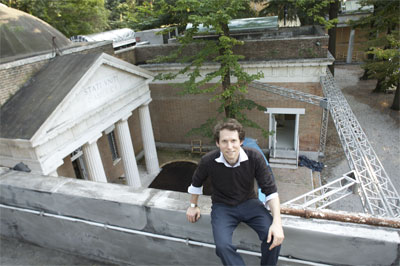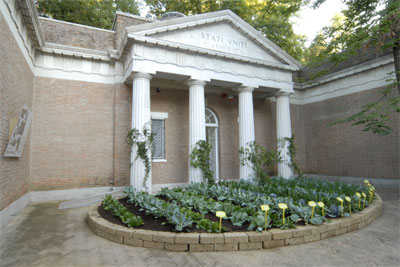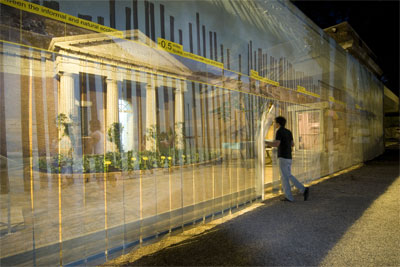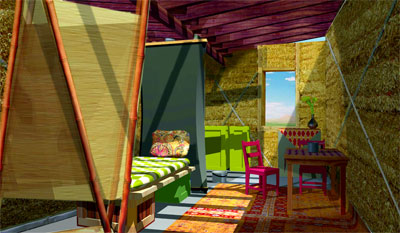
This week I spoke with Aaron Levy, Executive Director and a Senior Curator of the Philadelphia-based interdisciplinary non-profit art space Slought Foundation, about his participation in the U.S. Pavilion at La Biennale di Venezia, 11th International Architecture Exhibition. Working in a team with William Menking and Andrew Strum, the exhibition, titled "Into the Open: Positioning Practice," investigates contemporary socially-engaged architectural practice in the United States. Sixteen practitioners were selected for the exhibition, including The Center for Land Use Interpretation, the Center for Urban Pedagogy (CUP), Design Corps, Detroit Collaborative Design Center, Gans Studio, The Heidelberg Project, International Center for Urban Ecology, Jonathan Kirschenfeld Associates,Project Row Houses, Rebar, Rural Studio, Spatial Information Design Lab/Laura Kurgan, Studio 804, Smith and Others, The Edible Schoolyard/Yale Sustainable Food Project, and Estudio Teddy Cruz. Levy, along with William Menking and Andrew Strum, will discuss the exhibition at Columbia University on October 13th and downtown at Studio-X on October 14th. - Ceci Moss
Ceci Moss: The title for the U.S. Pavilion is "Into the Open: Positioning Practice." Considering the wide range of approaches represented in this exhibition, I'm wondering if you can discuss why you selected this title, and how it speaks to the premise of community involvement through architectural practice.
Aaron Levy: What should our place be in this world, and how should architects help shape our sense of place? These are two of the questions that our exhibition gestures towards, through a new American taxonomy of conflict and urgency that takes visitors through some of the richest and the poorest neighborhoods of North America. The sixteen practices we have selected embody an expanded definition of architectural responsibility, whereby architects and designers become activists, developers, facilitators of a more inclusive urban policy, and producers of unique urban research. The exhibition explores not just what these architects and activists have built, but how they have built. In this sense, it is very much in keeping with the contemporary focus on process.
I recently read Karsten Harries' The Ethical Function of Architecture, which follows Sigfried Giedion in arguing that the main task for architecture today is the interpretation of a way of life valid for our time. Harries argues that architecture is more than just an aesthetic approach, and that for some time now, architecture has been profoundly uncertain of its way. Can the problem of where architecture is going ever be thought separately from the larger problem of community and public forms of solidarity? Why must the ethical and the aesthetic always be in opposition? These questions are not just for philosophers; these are some of the questions that the field of architecture needs to consider today.

How did you become involved with this exhibition?
It's a really great question--although it doesn't have all that interesting an answer...There were a fair share of procedural and logistical headaches that are incredibly mundane though perhaps interesting to curators!
Our team (William Menking of The Architect's Newspaper, Andrew Sturm from PARC Foundation, and myself, in dialogue with architects Teddy Cruz and Deborah Gans) submitted a preliminary conceptualization to the U.S. Department of State's Bureau of Educational and Cultural Affairs (ECA), responding to a public call for proposals. Once our proposal was accepted, we only had about 90 days to actualize what was a fairly rough schematic and fundraise. The lack of easily available documentation for many of the community-oriented practices in our exhibition called into question a typical curatorial approach privileging the display of cultural artifact and encouraged us to highlight architectural process instead. We viewed limitations such as these productively, allowing them to organically determine our approach.
I can't even begin to describe how difficult it was to stage this exhibition in Venice! The biennale opens just days after Ferragosto, an Italian holiday which effectively shuts down Venice for the month of August. Additionally, everything in the exhibition -- from our shipping crates filled with cultural artifacts to the vegetables we planted in the courtyard of the pavilion for Alice Water's Edible Schoolyard -- arrived to the pavilion by barge (a rather curious process which you can view online on our blog). In hindsight, perhaps what was most difficult about curating the U.S. Pavilion was not the pressure to deliver, but rather the lack of time for extended deliberation -- an aspect that I think of as quite central to any curatorial process. The exhibition was ultimately installed on-site in less than two weeks, with the finishing touches made as the press conference began.
It is quite interesting that the different perspectives, tensions, and sensibilities that each member of our team brought to the table are still evident in the exhibition. What role should artifacts play? How should process be communicated without too heavily relying on text? What position should text and video occupy in the exhibition? In the end, we decided that visitors to the U.S. Pavilion should be able to interact and engage with the featured practices in a variety of ways, rather than through just one interface. There are models to interact with, video panoramas and slideshows to watch, but also books to read, blogs to contribute to, and even installations to walk through. The exhibition is less a site of formal instruction than one of participation and social critique. In this sense, the pavilion is decidedly unmonumental this year, intimate even, resisting spectacularity.
How did your work with Slought Foundation contribute to your position on the team?
At Slought Foundation, we encourage sociability and activism through public programs that are purposely critical and provocative; we invite audiences to consider culture and critical exchange as a source of dynamism and enjoyment. As a young organization, we stand for a quintessentially American do-it-yourself culture that is intellectually entrepreneurial and newly resurgent. Our projects take place in Philadelphia against a backdrop of inequality, urban blight, and socioeconomic disparity, which is very much in keeping with the practices and sites of conflict represented in the U.S. Pavilion.
In Venice, we were specifically interested in exploring how architecture can go beyond building (director Aaron Betsky's overall theme for this year's biennale), but also how architecture can go beyond the biennale itself. We wanted to invite viewers to think of architecture not just as a physical infrastructure but also as a social practice. Is an exhibition more than the display of models or cultural artifact? What is possible, and what is placed at risk, when architects become developers, work as artists, curators, or even community activists, acting not just intellectually but also entrepreneurially? We hope that the exhibition catalyzes contemporary practice by prompting questions such as these.
Many of the artists, architects and theorists we work with in Philadelphia and in Venice consider research as a fundamental component of their work; they challenge us to reconsider the politics of exhibition display and prevailing curatorial approaches by evading clear distinctions between artist, architect, critic, and curator. In Venice we also departed from past convention by omitting celebrity practices from consideration, instead highlighting projects with a grassroots, community sensibility. These practices work primarily with communities through complex choreographies of collaboration that balance on the edge of the professional. The sixteen practices offer sixteen different models of community engagement--a diversity of approaches in place of one.
Would you argue Slought Foundation's own place vis-à-vis the culture and community in Philadelphia provided you with a unique vantage point in which to think about civic engagement?
The selection of Slought Foundation (in partnership with PARC Foundation) to represent the United States is an enormous honor for our small West Philadelphia non-profit, but also recognizes a new spirit of community activism and inclusiveness across the country. Our selection highlights how the local site and emergent practices are newly empowered today, despite the absence of major public and private support for grass-roots social and cultural organizations that challenge conventional wisdom. In preparing for Venice, we thought a great deal about how to scale intimacy and informality to the international level of a biennale. European audiences seem to have noticed and appreciated these gestures of curatorial humility in representing the United States.
The curatorial statement describes how local initiatives, such as Project Row Houses and the Heidelberg Project, arose out of the lack of large-scale public infrastructure projects in the United States. While these organizations successfully and creatively navigated private, public, and non-profit sectors in order to support and stage their projects, their existence also speaks to the abandonment, in part, of the communities they serve by larger government. Given the potential overreaching effects of the economic downturn of the past few weeks, do you see local initiatives such as these becoming more central to the health and well being of our cities? Could you argue that this direction is potentially problematic?
I completely agree. In the absence of large-scale public infrastructure projects in the United States, local initiatives are necessarily becoming newly empowered and dynamic arenas for the exploration and generation of new forms of sociability and activism. Teddy Cruz has referred to this development as the "radicalization of the local;" by this he means that the unique complexity of the local urgently demands our attention today. Project Row Houses and the Heidelberg Project are two great examples of the way in which grassroots non-governmental organizations are reclaiming the ability to shape community and the built environment on the scale of the individual neighborhood.
You collaborated with architects Teddy Cruz and Deborah Gans for this exhibit. I wanted to touch on their work, because their individual projects take on issues of migration and national boundaries. Due to a continued growth of population displacement, movement, and migration, these in-between zones have become more prevalent. Can you tell us more about their practices? Within the nation-specific format of the biennial, how were their ideas in particular framed in the exhibition?
Estudio Teddy Cruz's contribution to the U.S. Pavilion is a photographic reproduction of the border fence that spans the U.S. border with Mexico at San Diego. It is at once a form of architectural research and a political practice of intervention. This visual representation of the border, together with its photographic montage illustrating the 30 miles north and south of the fence, take visitors through a landscape of conflict that courses through the affluence north of San Diego and the homelessness and neglect in Tijuana. Visitors to the pavilion literally and metaphorically pass through perforations in this porous border to enter the exhibition in the courtyard and inner galleries. These perforations, rather than taking the form of clear interruptions or breaks along the entire facade, instead take the form of small, vertical micro-incisions, thus encouraging on the part of the visitor a landscape of swerves and detours. With this small shift in perspective, the seemingly formal relationship between San Diego and its informal counterpart Tijuana, gives way to San Diego and Tijuana being understood as part of the same, larger urban system.

Gans Studio is devoted to rethinking how architecture can participate in the emergence of social forms. It focuses on extreme situations that also foretell the general. It has designed housing and infrastructure for populations displaced by environmental and political disaster in Kosovo, New Orleans, and New York City. The current universal solution to refugee housing is a tarp that cannot withstand extreme climate conditions; it does not provide for basic domestic needs such as bathing and cooking. Refugee camps lack many forms of urban infrastructure and also deplete natural resources, wreaking ecological havoc and disempowering the refugee population in their will to become self-sufficient.
For the biennale, Deborah Gans designed a "Roll Out House" prototype that responds to the extremely degraded conditions on Native American reservations, where a lack of infrastructure and endemic poverty calls for an urgent and easily deployable response. A house can be rebuilt around the deployed "roll out" house. One column holds a cistern, and the other a kitchen. Three hollow columns of various materials can support a roof or even a second floor. They also make possible a domestically-scaled infrastructure of waste, water, or heat. The "roll out" houses can also be assembled in larger formations to cultivate the structure of a town. A physical and social infrastructure emerges according to new principles of "roll out" housing.

The theme for this year's biennial is "Out There: Beyond Architecture"- thus salient topics such as the implementation of emerging technologies with architectural practices, green design, and the intersection between contemporary art and architecture were elaborated in the exhibits. Clearly, there's an underlying progressive ethos at work here, and I'm wondering if there will be any effort to continue these dialogues and/or projects beyond the realm of the biennial.
Right now our organization is working to realize a mixed-income, mixed-use community development near Lancaster Avenue here in Philadelphia. We are undertaking this project with People's Emergency Center, a social services and community development corporation, in partnership with PARC Foundation and Estudio Teddy Cruz.
The exhibition in Venice is therefore a sort of testing ground, a conceptual prelude to what we hope to actualize in the coming months in Philadelphia. Although we are still in the planning stages, we envision a series of social and cultural services being joined under one roof, including digital inclusion programs, employment offices, and a dedicated space for Slought Foundation. In so doing, we hope to mitigate the paucity of social and cultural organizations in neighborhoods of need.

